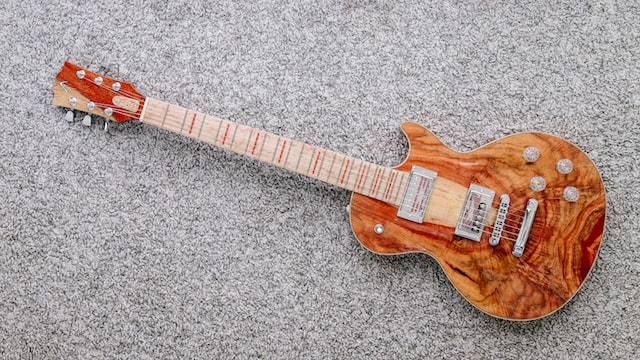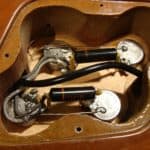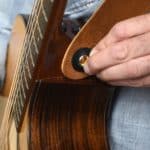When comparing different guitar models, particularly modern with older ones, you might have come across these 3 terms referring to their tops.
Are these interchangeable?
What are the actual differences between a guitar top, cap, and veneer?
The main difference between guitar tops, caps, and veneers is that the term “top” just refers to a piece of wood glued over the instrument’s body. Tops have aesthetic purposes and can be of two kinds: caps, which are thicker and shape the instrument’s tone, and veneers which are extremely thin.
In this article, I will tell you all you need to know about these 3 different denominations, how to differentiate each one, and if you should worry about it at all.
After leaving this page you will have a deeper understanding of how some guitars are built.
Are you ready to get started?
Let’s go!
What is a guitar top?
A guitar top is a layer of wood, usually different than the one used in the rest of the guitar body, that’s glued on top of it and serves aesthetic and functional purposes in terms of helping to shape the final tone of the instrument.
The denomination top usually includes caps and veneers which are two different approaches to the same thing, however, it’s common for players to use this term interchangeably with cap.
Guitar tops are a staple on more luxurious instruments, and commonly manufacturers use figured or exotic woods for them.
They are also commonly carved, another process that adds to the costs of manufacturing, and enhances the premium aesthetic.
What is a guitar cap?
Cap is not that common of a term as “top” but adds specificity to the type of top a guitar has.
Guitar caps are thick layers of wood, that end up being about a quarter of the overall instrument’s body thickness, and that serve not only a visual purpose but also a sound-shaping one.
Some players argue that the thicker the cap the more impactful it is on the instrument’s tone, and that can certainly be true.
Of course, being that caps are usually built using expensive tonewoods that also have the particularity of being figured and eye-catching, it’s natural that only high-end instruments will go for this kind of top.
What is a guitar veneer top?
Veneer tops or veneers on guitars are a cost-effective way of getting the looks of a guitar body cap but at a way more affordable level.
It’s just one of the simplest tricks in the book for manufacturers: Just a thin slice of that costly figured wood is enough to imprint its looks on the guitar.
Needless to say, this kind of top only obeys aesthetic purposes and has no impact whatsoever on the instrument’s sound.
They are way too thin to have a meaningful impact.
So thin that, in fact, they can’t be sanded down without losing their figure, and don’t take dyes very well.
Manufacturers usually go for veneers when trying to “hide” bodies built with multiple different pieces of wood that don’t match purposefully.
And don’t get me wrong, I think they can give a great look to entry-level instruments that otherwise would only just look cheap with their multi-piece jigsaw-looking glued bodies.
Do all guitars have a top, cap, or veneer?
No, not all guitars necessarily have a top, cap, or veneer. It’s just a design feature that only some brands decide to incorporate and not a fundamental part of a guitar.
Perhaps this might sound counterintuitive if you come from the acoustic guitar where the top can be the most important part of its body, but for electric guitars just having a body is good enough.
Fender guitars, for instance, are some of the most sought-after instruments among players and they just don’t have any kind of top.
And I mentioned that guitar caps can take an important role in shaping the tone of the instrument, but for some instruments, their sound is the sound of not having a top at all.
What is the main difference between guitar tops, caps, and veneers?
The easiest way of understanding the difference between these 3 terms used to describe a part of some guitar’s bodies is by organizing them hierarchically.
The term “top” refers, on a higher level to a piece of wood, commonly a figured wood, that’s glued over a guitar’s body to enhance it in some way.
The term “cap” refers to guitar tops that have a certain thickness, that can be of up to a quarter of the overall instrument’s body, and that are used to both shape the guitar’s tone and for aesthetic purposes. Caps are commonly used on high-end guitars.
The term “veneer” refers to guitar tops that are extremely thin and that are only intended to provide a visual improvement to the instrument. Veneers are mostly used on more affordable versions of guitar models that come with a cap top.
Do guitar tops affect the tone of the instrument?
As with anything that’s attached to a guitar, tops do have an impact on the instrument’s final sound.
Some players describe that the maple top on a Gibson Les Paul, for instance, gives it a slight mid scoop that’s a characteristic part of its tone.
I’ve written a more in-depth article about how tops affect the tone of a guitar, you can check it out here:
Are guitar tops only aesthetic?
Although a lot of players like to argue that the only factor that defines the tone of an electric guitar is its pickups, I disagree with that opinion.
Guitar tops were probably originally intended as a luxury add-on for higher-end guitars but ended up not only working in that way but also shaping their sound.
Veneers, however, are only a way of making a guitar look like it has a proper cap top, but at a way more affordable price, serving only aesthetic motivations, since they don’t have enough mass to be impactful at all.

Hello there, my name is Ramiro and I’ve been playing guitar for almost 20 years. I’m obsessed with everything gear-related and I thought it might be worth sharing it. From guitars, pedals, amps, and synths to studio gear and production tips, I hope you find what I post here useful, and I’ll try my best to keep it entertaining also.





